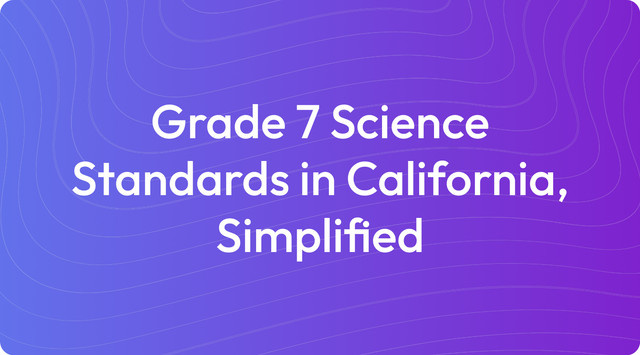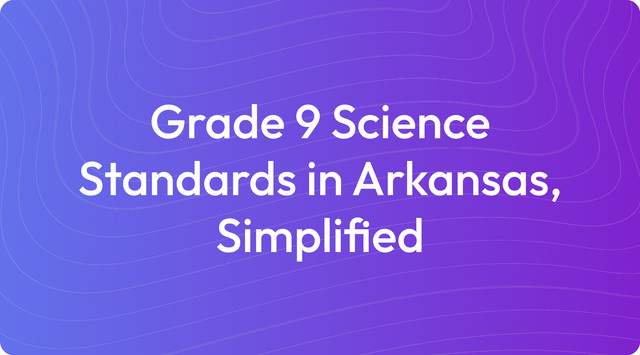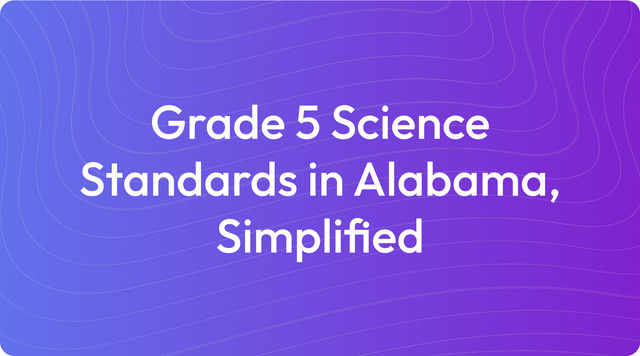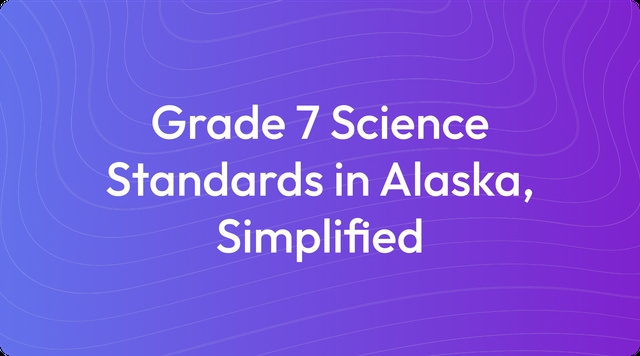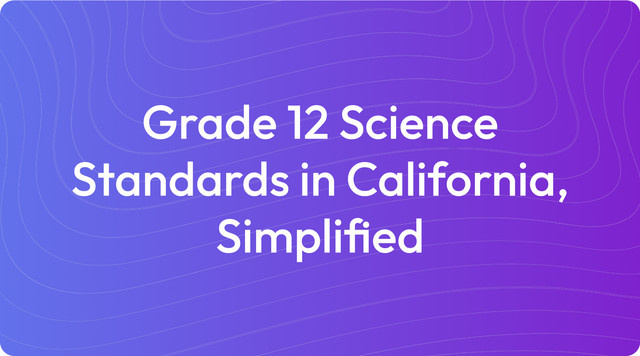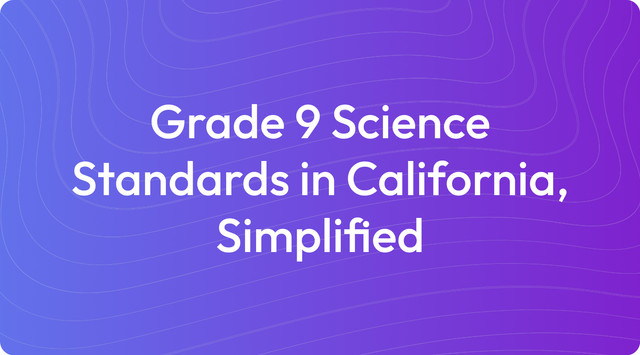Grade 1 Science Standards in California, Simplified
California’s Grade 1 science standards focus on exploring plants, animals, and everyday patterns with hands-on experiences and curiosity-driven activities.

Understanding education standards is a key part of curriculum planning. We know you're looking for clarity on what's expected in your classroom. These guidelines provide a framework for student learning, helping you structure your lessons effectively throughout the school year.
Education standards are learning goals that outline what students should know by the end of a grade level. For teachers, they serve as benchmarks, not a prescriptive curriculum; you decide on the specific activities and teaching methods. For instance, California's Grade 1 Science Standards set a goal for students to understand that vibrating materials make sound, but you have the flexibility to design how they explore that concept in your classroom.
What Are Grade 1 Science Standards in California?
The Grade 1 Science Standards in California are part of the California Next Generation Science Standards (NGSS). These standards are organized into several key areas of study to guide your first graders as they explore the world through observation and inquiry.
Here are the key areas of Grade 1 Science Standards in California:
- Physical Science (PS):
- PS4: Waves and Their Applications in Technologies for Information Transfer
- Key Standard (1-PS4-1): Plan and conduct investigations to provide evidence that vibrating materials can make sound and that sound can make materials vibrate.
- Key Standard (1-PS4-2): Make observations to construct an evidence-based explanation that objects can be seen only when illuminated.
- Key Standard (1-PS4-3): Investigate how light interacts with objects (transparent, opaque, reflective).
- PS4: Waves and Their Applications in Technologies for Information Transfer
- Life Science (LS):
- LS1: From Molecules to Organisms: Structures and Processes
- Key Standard (1-LS1-1): Use evidence to explain how plants and animals meet their needs for survival (e.g., sunlight, water, food, air).
- Key Standard (1-LS1-2): Read texts and use media to determine patterns in animal behavior (e.g., why animals migrate or hibernate).
- LS3: Heredity: Inheritance and Variation of Traits
- Key Standard (1-LS3-1): Make observations to compare how young plants and animals are alike or different from their parents.
- LS1: From Molecules to Organisms: Structures and Processes
- Earth and Space Science (ESS):
- ESS1: Earth’s Place in the Universe
- Key Standard (1-ESS1-1): Use observations of the sun, moon, and stars to describe patterns that can be predicted (e.g., sunrise and sunset times).
- Key Standard (1-ESS1-2): Make observations at different times of the year to relate the amount of daylight to the time of year.
- ESS1: Earth’s Place in the Universe
- Engineering, Technology, and Applications of Science (ETS):
- ETS1: Engineering Design
- Key Standard (K-2-ETS1-1): Ask questions, make observations, and gather information to define a simple problem that can be solved through engineering (e.g., designing solutions to protect plants from sunlight or wind).
- ETS1: Engineering Design
The standards also emphasize the following Key Crosscutting Concepts (CCCs):
- Patterns: Observing patterns in nature (e.g., day/night cycles, animal behaviors)
- Cause and Effect: Understanding how light, sound, and vibrations interact with materials
- Structure and Function: Exploring how the structures of plants and animals help them survive
The framework for these standards is guided by the Next Generation Science Standards and the California Department of Education.
Key Tested Standards
In California, the key tested standards for first grade focus on foundational concepts across the major scientific domains. These standards are designed to be assessed through hands-on investigation and observation, rather than rote memorization. Here are the key standards you can expect to be assessed:
1. Physical Science (PS): Waves and Their Applications
- 1-PS4-1: Sound and Vibrations: Plan and conduct investigations to provide evidence that vibrating materials can make sound, and sound can make materials vibrate.
- 1-PS4-2: Light and Illumination: Make observations to explain that objects can be seen only when illuminated.
- 1-PS4-3: Light and Materials: Investigate how light interacts with different materials (e.g., transparent, opaque, reflective).
2. Life Science (LS): Structures and Functions in Plants and Animals
- 1-LS1-1: Plant and Animal Survival: Use evidence to explain how plants and animals meet their needs for survival (e.g., sunlight, water, food, air).
- 1-LS1-2: Animal Behavior Patterns: Read texts and use media to determine patterns in animal behavior (e.g., migration, hibernation).
- 1-LS3-1: Inheritance and Traits: Make observations to compare how young plants and animals are similar to, but not exactly like, their parents.
3. Earth and Space Science (ESS): Patterns in the Sky
- 1-ESS1-1: Patterns of the Sun, Moon, and Stars: Use observations to describe predictable patterns of the sun, moon, and stars.
- 1-ESS1-2: Seasonal Daylight Changes: Make observations to explain how the amount of daylight changes throughout the year.
4. Engineering, Technology, and Applications of Science (ETS): Problem-Solving
- K-2-ETS1-1: Define and Solve Simple Problems: Ask questions, make observations, and gather information to define a problem and design a solution.
These key tested standards are aligned with the official topic arrangements from the Next Generation Science Standards and the content standards adopted by the California Department of Education.
Example Learning Objectives for Unit Planning
Learning objectives break down the broader standards into specific, measurable goals for each lesson. They act as a clear guide for you and your students, outlining what learners should be able to do by the end of a class. To give you a clearer picture, here are some example learning objectives for two Grade 1 Science Standards, written in student-friendly “I can” statements:
Standard: 1-PS4-1
(Plan and conduct investigations to provide evidence that vibrating materials can make sound and that sound can make materials vibrate.)
Learning Objectives:
- I can investigate how hitting, plucking, or tapping objects (like a drum or rubber band) creates vibrations and sound.
- I can explain that sound is caused by vibrations I can see or feel.
- I can observe and describe how sound can make materials move, like how sound waves make rice jump on a drum.
Standard: 1-LS1-1
(Use evidence to explain how plants and animals meet their needs for survival, such as sunlight, water, air, and food.)
Learning Objectives:
- I can identify what plants and animals need to survive (e.g., water, air, sunlight, or food).
- I can explain how plants get sunlight and water to grow.
- I can describe how animals find food and water in their environment to stay alive.
- I can observe and record how plants change when they don’t get what they need.
Key Changes & Updates
The most significant update to California's Grade 1 Science Standards came with the adoption of the California Next Generation Science Standards (NGSS) in 2013. This introduced a framework known as “three-dimensional learning,” which moves instruction away from memorization and toward active inquiry. This approach combines three key elements: Science and Engineering Practices (what students do), Crosscutting Concepts (big ideas that connect different topics), and Disciplinary Core Ideas (foundational knowledge). For your classroom, this means students are now expected to investigate phenomena, ask questions, and solve problems, much like scientists and engineers do.
This shift brings a greater focus on hands-on investigation and the integration of engineering design into your science lessons. Instead of just learning facts, students are encouraged to design solutions for simple problems and make connections to the world around them. The standards also promote integration with other subjects, like math and ELA, as students record data or read texts to support their findings. The goal of these changes is to foster deeper engagement and critical thinking, building a strong foundation for future learning in science and technology.
Create with TeachShare
We understand that designing lessons to meet every standard takes valuable time and effort. Our platform is built to support you by making it simple to create engaging, standards-aligned materials. You can generate activities, differentiate for student needs, and build entire lessons based on sound pedagogy, freeing you up to focus on what you do best—teaching. Start creating standards-aligned instructional resources with TeachShare now.
Frequently Asked Questions
What are the main topics covered in Grade 1 Science?
First-grade science introduces students to foundational concepts across three core areas. Here is a look at what is covered:
- Physical Science (PS): Exploring light, sound, and the vibrations that cause them
- Life Science (LS): Understanding the needs of plants and animals, how traits are passed down, and behavioral patterns in animals
- Earth and Space Science (ESS): Observing patterns related to the sun, moon, and stars, including changes in daylight throughout the seasons
Students also get an introduction to Engineering (ETS) by designing solutions to simple, real-world challenges.
What is the biggest change with the updated NGSS standards?
The updated standards represent a significant shift away from rote memorization. The focus is now on hands-on, inquiry-based learning where students actively explore phenomena. This approach is built on a framework known as three-dimensional learning. Here are its components:
- Science and Engineering Practices (SEPs): Students learn by doing science—asking questions, conducting investigations, and solving problems.
- Crosscutting Concepts (CCCs): These are major themes, like patterns or cause and effect, that link different scientific topics together.
- Disciplinary Core Ideas (DCIs): This is the essential subject matter within physical, life, and Earth sciences.
How do these standards connect to real-world experiences?
The standards are designed to make science relevant by connecting it directly to students' daily lives. Instead of abstract facts, learning is anchored in observable, everyday phenomena. Here are a few examples:
- Investigating why we need light to see objects
- Observing how sunlight affects plant growth
- Tracking how sunrise and sunset times change with the seasons
These connections help make science more meaningful and engaging for young learners.
What are some examples of classroom activities?
You can bring the standards to life with a variety of hands-on activities. Here are some ideas for the classroom:
- Physical Science: Give students flashlights to see how light behaves with different materials like mirrors, glass, and paper to learn about reflection and transparency.
- Life Science: Grow two sets of plants—one in sunlight and one in the dark—to demonstrate the importance of light for survival.
- Earth Science: Have students observe and draw the shape of the moon each night for a week to identify patterns.
- Engineering: Challenge students to design and build a small shade structure that can protect a plant from excessive sunlight.
How are students assessed in Grade 1 Science?
Assessment in first grade moves beyond traditional tests and focuses on observing what students can do. Here are the primary ways student understanding is measured:
- Hands-on Investigations: Teachers can assess students as they perform experiments, like testing how different objects create sound through vibrations.
- Data Recording: Students can be evaluated on their ability to track and record observations, such as noting plant growth or changes in the moon's appearance.
- Models and Drawings: Creating simple models or drawings to explain a pattern, like the phases of the moon, serves as a form of assessment.
- Explanations: Students demonstrate their learning by explaining, either verbally or in writing, what they observed and concluded from an activity.
Answer


